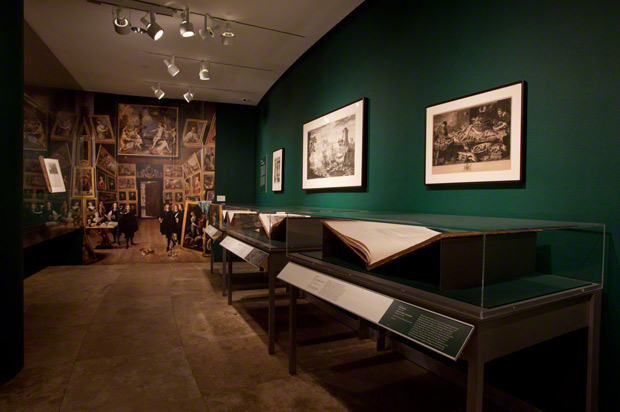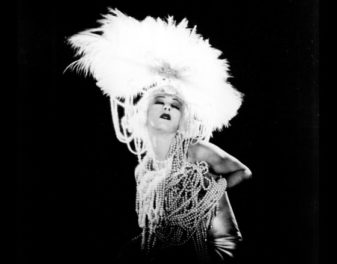In the 1700s, the seeds of a new style of presenting works of art—both on the wall and on the page—were planted by a German prince.
I talked with Louis Marchesano, curator of prints and drawings at the Getty Research Institute, about the prince and his story, which is told in the exhibition Display & Art History: The Düsseldorf Galley and Its Catalogue, closing Sunday. He explained how the bold ideas of an influential group of royal art collectors, patrons, and artists influenced how we experience and learn about art today.

Tell me about the prince and his gallery.
German prince Johann Wilhelm II von der Pfalz lived in Düsseldorf, one of the principalities of what is now Germany. He was one of a number of “electors” who could vote for the Holy Roman Emperor. Electors competed with each other over their art collections and Prince Johann Wilhelm, along with his first and second wives, built an incredible collection of paintings. They were mostly Italian, Flemish, and Dutch works. To house them, he constructed one of the first independent galleries for displaying artworks.
Usually, paintings were installed in princely residences, but he put his best, most important paintings in a separate building attached to the palace. The gallery was dedicated solely to the appreciation of art.
What did the galleries in those princely residences look like?
In this print, you see that the paintings are hung floor to ceiling. A viewer was meant to be overwhelmed by the sheer number of paintings and the wealth of the collector and patron.

View of a Room at Pommersfelden Palace, Johann Georg Pintz, printmaker; Salomon Kleiner, draftsman; in Representation au naturel des chateaux… (Augsburg, 1728), pl. 18. The Getty Research Institute, 84-B21917
How did the Düsseldorf Gallery depart from the accepted style of displaying art?
In the Düsseldorf Gallery, fewer paintings were hung on a wall, allowing for more space between them. In addition, the pictures were carefully arranged, allowing viewers—who would have included artists in training—to compare and contrast them. One picture might be intended to terrify and might therefore been seen as an exemplar of that emotion. Another might give a sense of gracefulness.
Each of the walls was something like an art history lesson meant to appeal to a broad audience. This approached a kind of rational Enlightenment attitude toward showing pictures.

View of the third room of the Düsseldorf Gallery; detail of a printer’s proof for Nicolas de Pigage and Christian von Mechel, La galerie électorale de Dusseldorff… (Basel, 1778). The Getty Research Institute, 870670.21
Whose idea was this new approach to displaying art?
Lambert Krahe, the director of the Düsseldorf Art Academy, was hired in 1756 to be the director of the Düsseldorf Gallery. After Prince Johann Wilhelm II died, his nephew and eventual successor, Carl Theodor, allowed Krahe to rehang the collections, which had been in storage during the Seven Years’ War. Krahe should be admired today as one of the most remarkable curators of the early modern period; he had a great eye.
Tell me about Krahe’s grand vision to create a catalogue of the collection.
Krahe got permission from his patron to copy the paintings, to make prints, and to sell them. Krahe wanted to publish a Galeriewerk, an album of large-scale reproductive prints of paintings. These Galeriewerke were also given as gifts to other courts. Most people today know paintings through photographs—but back then, you learned about them through the kinds of reproductive prints that populated these large albums.
In order to produce an album of prints, he had to make accurate drawings of each of the original paintings—and making copies was costly. Then, the drawn compositions had to be transferred to copperplates and reproduced by the hundreds. Only four plates were actually completed before Krahe almost went bankrupt, and abandoned the project.

Drawings created for the Galeriewerk. At top left and right, sketches after the painting St. John the Baptist in the Wilderness by Daniele da Volterra, which was believed at the time to be by Raphael. The Getty Research Institute, 870670.13
Was this the first attempt to create a Galeriewerk of an art collection?
No. In mid-17th-century Europe, there were successful illustrated art books made by the finest printmakers, which were sent to different courts to advertise the patrons’ exceptional taste. The first volume was the Theatrum pictorium from the collection of Archduke Leopold Wilhelm. But these weren’t precursors to the modern museum collection catalogues because they were meant to present the pictures, rather than explain with text.
Back to the Galeriewerk of the Düsseldorf Gallery, you said another attempt was made?
Twenty years after Krahe failed and around the time of his death in the 1770s, an English printmaker came on the scene. Valentine Green convinced Carl Theodor, who wanted to promote his inherited collection through a large album of prints, to give him access to 100 paintings, a selection from the entire Düsseldorf collection. His strategy was to entice collectors to subscribe to this project by exhibiting copies painted after the original paintings, which he would reproduce in print, such as St. John in the Wilderness. It was an extraordinarily complex and expensive process; Green made 21 prints before he actually went bankrupt.
How was the Düsseldorf Catalogue ultimately made?
Carl Theodor sent the preparatory materials for Krahe’s Failed Galeriewerk to his court architect, Nicolas de Pigage, who worked with printmakers to create what became one of the first modern catalogues.
It wasn’t a big, spectacular princely volume that highlighted treasures from a collection. It provided a systematic overview of a carefully displayed collection. It was published in two volumes, with text and illustrations and an analysis of each painting. It reflected the spirit of Krahe’s original installation.
Did the publisher, printmakers, and their royal patrons know they were changing the way art would ultimately be viewed and studied?
No. It’s only in retrospect that we see this as an important moment in the history of art.




Comments on this post are now closed.
Trackbacks/Pingbacks